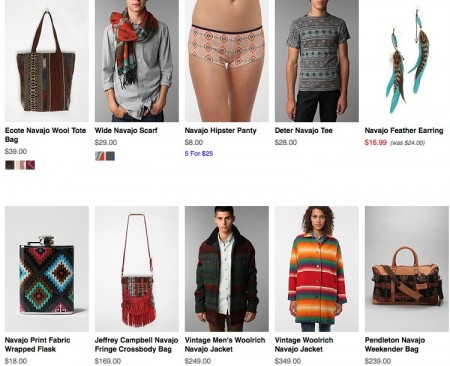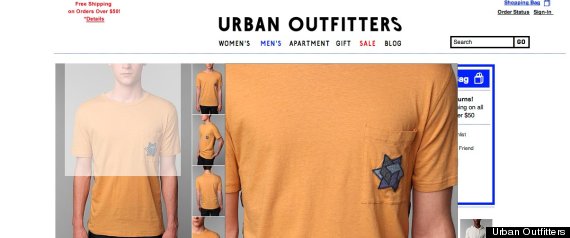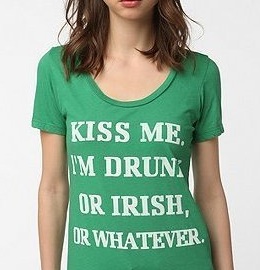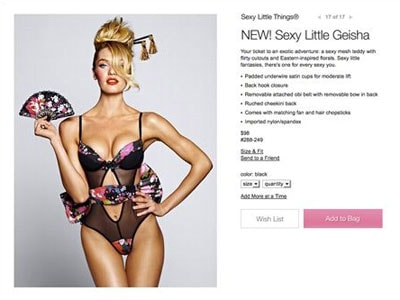Welcome to College Fashion’s biweekly column, Fashionably Informed. As a CF reader, it’s clear that you love fashion. But have you ever wondered about the drama that goes on behind the scenes? To keep you up to speed, this column aims to inform you about important issues and controversies in the fashion industry.
In case you missed them, see past posts on Retouching & Photoshopping, Tanning Promotion in the Media, Hypocrisy in Beauty Marketing, Racism in the Modeling Industry, “White-Washing” & Skin Lightening, and Homosexuality in the Fashion Industry.

Urban Outfitters’ “Navajo”-Inspired Clothing Line | Photo Credit
For this week’s post, we are returning to our series on racism in the fashion industry. Over the past few months, we have discussed Racism in the Modeling Industry and “White-Washing” & Skin Lightening. This time, we are tackling a slightly different topic: cultural appropriation andstereotyping of culture and ethnicity in retail fashion.
This topic idea was derived from a suggestion by CF reader Amanda. She commented on the last article in our series on racism, saying:
I would be interested in seeing an article on the appropriation of other cultures in the fashion industry. Especially prominent right now is the appropriation of Native American and Asian cultures. Anyway, thanks again!
Thank you, Amanda, for your excellent suggestion. Just last week, media outlets went wild about Victoria’s Secret’s “Sexy Little Geisha” costume,but we will get to the topic later in this post.
The Victoria’s Secret controversy is just one example among many: Numerous retailers have offended consumers by portraying races and cultures in stereotypical and negative ways, or trivializing cultures by turning them into “trends.” Native American and Asian cultures are perhaps appropriated and stereotyped the most in the US, however this issue affects a wide range of cultural groups.
Given that today is both Columbus Day and Indigenous People’s Day, it’s an ideal time to raise awareness about the topic, in hopes that we can all recognize these acts when they occur and work together to change the way cultures are portrayed in fashion.
While stereotyping and appropriation happen across the industry – in magazines and ads, and on the runways – today, we’re going to focus on controversies surrounding popular retail stores.
Table of Contents
First, a Few Definitions
Before we get started, let’s define a few terms so we’re all on the same page.
According to Wikipedia, “cultural appropriation” is defined as follows:
Cultural appropriation is the adoption of some specific elements of one culture by a different cultural group. It describes acculturation or assimilation, but can imply a negative view towards acculturation from a minority culture by a dominant culture. It can include the introduction of forms of dress or personal adornment, music and art, religion, language, or social behavior. These elements, once removed from their indigenous cultural contexts, can take on meanings that are significantly divergent from, or merely less nuanced than, those they originally held.
When we refer to “stereotypes,” we are using the following definition, again from Wikipedia. (Note the differences between stereotypes, prejudices, and discrimination):
Stereotypes, prejudice and discrimination are understood as related but different concepts. Stereotypes are regarded as the most cognitive component, prejudice as the affective and discrimination as the behavioral component of prejudicial reactions. In this tripartite view of intergroup attitudes, stereotypes reflect expectations and beliefs about the characteristics of members of groups perceived as different from one’s own, prejudice represents the emotional response, and discrimination refers to actions.
Although related, the three concepts can exist independently of each other. According to Daniel Katz and Kenneth Braly, stereotyping leads to racial prejudice when people emotionally react to the name of a group, ascribe characteristics to members of that group, and then evaluate those characteristics.
Now that we all understand what these terms mean, let’s talk about some recent examples of appropriation and stereotyping in retail fashion. Below, I’ll lay out a few different incidents affecting a number of cultural groups.
Urban Outfitters
Urban Outfitters has been accused several times of portraying cultures in a negative or inappropriate manner. Each time, they have stated that they had no intention of offending anyone. In many cases, UO has ended up removing the offending items from stores.
“Navajo” Clothing Line
About a year ago, Urban Outfitters came under fire for their “Navajo”-inspired clothing line. The fashion retailer featured several designs that they labeled as “Navajo” (see top photo above). These included a “Navajo Hipster Panty” and a “Navajo Print Fabric Wrapped Flask.”
While numerous people found these items offensive, perhaps no one was more insulted than the Navajo National Government. They were firstly offended by the portrayal of their culture as a mere fashion trend. However, an additional problem was that these “trendy” items were labeled “Navajo”.
According to The Globe and Mail, the Navajo National Government “holds a dozen trademarks on the name, encompassing clothing, textiles, household products and other items.” Consequently, the Navajo Nation Government sent a cease-and-desist letter to Urban Outfitters, demanding that they remove the trademarked name from the items in question.
In a statement to the Associated Press, the tribe’s attorney said,
“When products that have absolutely no connection to the Navajo Nation, its entities, its people, and their products are marketed and retailed under the guise that they are Navajo in origin, the Navajo Nation does not regard this as benign or trivial. It takes appropriate action to maintain distinctiveness and clarity of valid name association in the market and society.”
Along with the Navajo National Government, numerous Native Americans across the country were deeply offended. On the news blog, Racialicious, guest contributor Sasha Houston Brown wrote an open letter to Urban Outfitters’ CEO. In it, she said,
In all seriousness, as a Native American woman, I am deeply distressed by your company’s mass marketed collection of distasteful and racially demeaning apparel and décor. I take personal offense to the blatant racism and perverted cultural appropriation your store features this season as “fashion.”
In response to the demands of the Navajo National Government and other offended individuals, Urban Outfitters told the Associated Press,
“Like many other fashion brands, we interpret trends and will continue to do so for years to come. The Native American-inspired trend and specifically the term ‘Navajo’ have been cycling through fashion, fine art and design for the last few years.”
While Urban Outfitters denied any wrongdoing in their statement, they subsequently removed the word “Navajo” from the products in question. The Hufington Post reported that the offensive items were renamed.
Despite Urban Outfitters’ actions to re-name the products, according to The Guardian, the Navajo Government filed a lawsuit against the company. The fashion retailer removed the “Navajo” name from the products on their website – however, the lawsuit asserted that the names remained in other places. The Guardian explains:
But the lawsuit claims that products with the Navajo name were still being sold through other company brands, such as Free People, in catalogues and retail outlets.
The lawsuit is still ongoing, as is the controversy.
“Jewish Star” T-Shirt

Urban Outfitters’ shirt featuring “Jewish Star” | Photo Credit
Earlier this year, Urban Outfitters featured a shirt on their website that deeply insulted the Jewish community and others. The problem was that the shirt (pictured directly above) had a patch on its pocket that bore a strong resemblance to the Star of David, which Jewish individuals were forced to wear during the Holocaust.
The Huffington Post reported that the star outraged the Anti-Defamation League (ADL) of Philadelphia. In their statement about the controversy, ADL’s regional director wrote,
We find this use of symbolism to be extremely distasteful and offensive, and are outraged that your company would make this product available to your customers.
The shirt was deemed offensive due to the Star of David’s connection to the Holocaust and Nazism. However, the brand, WoodWood, who produced the shirt, denied any intentional representation of the Holocaust. In response to ADL’s statement, WoodWood stated the following:
First of all the graphic is not the Star of David, and I can assure you that this is in no way a reference to Judaism, Nazism or the holocaust. The graphic came from working with patchwork and geometric patterns for our spring/summer collection ‘State of Mind’. However when we received the prototype of this particular style we did recognize the resemblance, which is why we decided not to include the star patch on the final production T-shirt. I assume the image people have reacted to come from Urban Outfitters´ web site. This must be a photograph of an early sample, which is of course an error. Here is the actual T-shirt as it is in stores. I am sorry if anyone was offended seeing the shirt, it was of course never our intention to hurt any feelings with this.
As you can see from the statement, WoodWood denied that the star was a reference to Judaism, but also claimed that the shirt published on Urban Outfitters’ site was an early sample of the t-shirt. To WoodWood’s credit, the final product did not include the star in any way.
However, this was not the only time Urban Outfitters offended members of the Jewish community. According to the ADL, UO produced another shirt that many found offensive. This shirt included the phrase, “Everyone Loves a Jewish Girl,” surrounded by dollar signs. After a largely negative response, UO pulled the shirt.
St. Patrick’s Day Collection

Urban Outfitters’ St. Patrick’s Day T-Shirt
Urban Outfitters also came under fire for their portrayal of the Irish community, specifically because of their St. Patrick’s day mechandise. The fashion retailer was accused of supporting negative stereotypes of Irish and Irish-Americans. The offending collection included tanks and t-shirts with sayings such as “Kiss Me. I’m Drunk, or Irish, or Whatever.” (pictured above) and “Irish I was Drunk.”
Members of the Irish community demanded that Urban Outfitters pull the items, which they deemed offensive. According to Politicker, Joe Crowley, the co-chair of the legislature’s Ad Hoc Committee on Irish Affairs, wrote a letter to the company’s CEO demanding the products be removed. In his letter, Crowley explains the effects of the clothing items:
We recently learned of images used by Urban Outfitters in its St. Patrick’s Day clothing line that depict severe and negative stereotypes of Irish and Irish-American people as well as may promote binge drinking. We strongly urge you to end the sale of these items.
Urban Outfitters has not responded to this controversy.
Abercrombie and Fitch
Of course, Urban Outfitters is not the only brand to come under fire for their portrayals of cultural groups. Abercrombie and Fitch caused outrage when they began selling t-shirts that featured what some deemed a stereotypical portrayal of Asian individuals and culture.The San Francisco Chronicle reported that the shirts featured “caricatured faces with slanted eyes and rice-paddy hats.” One of the shirts also included the phrase, “Wong Brothers Laundry Service — Two Wongs Can Make It White.”
Abercrombie’s representation of Asian culture, to many, demonstrated the historic stereotypes often placed on the Asian community. This stereotypical representation outraged numerous people and many demanded the removal of these shirts. Despite the negative response, a spokesperson from Abercrombie’s PR firm told the SF Chronicle,
“We personally thought Asians would love this T-shirt. We are truly and deeply sorry we’ve offended people”
In a follow-up article, The SF Chronicle reported that after protests and threats of boycotts, Abercrombie and Fitch removed the shirts from their stores and website.
Victoria’s Secret and the “Sexy Little Geisha”

Victoria’s Secret “Sexy Little Geisha” Costume | Photo Credit
Last week, numerous media outlets reported about the controversy surrounding Victoria’s Secret “Sexy Little Geisha” costume (pictured above). The costume includes a sheer and floral printed body suit, a fan, and chopsticks meant for your hair. The lingerie company was accused by many blogs and news sites of perpetuating stereotypes of Asian women by selling this costume.
Racialicious cited the important historical context that surrounds this costume and the idea it represents. They stated,
Donning a “sexy Geisha” outfit to get the ball rolling in the bedroom remains offensive because it confirms a paradigm in which Asian people and their culture can be modified and sexualized and appropriated for the benefit of the West. This particular kind of racism has existed for a long time, and we’re far from moving beyond it.
The Frisky also refered to the long-standing stereotype of the “sexualized” Asian woman, saying,
It’s an entire outfit — a sex costume, really — based on the accoutrements of the Japanese geisha to make your lingerie “exotic” and signify the sexual submission and exploitation of Asian women.
Numerous other blogs and articles echoed Racialicious and The Frisky’s comments about the controversy. While the representation of the stereotype of Asian women as hyper-sexualized and submissive caused outrage, many were also upset by the use of the term “Geisha.” The Frisky pointed out the not-so-glamous past of geishas,
Considering the complicated history of geishas, repurposing the “look” for a major corporation to sell as role-playing lingerie seems a bit tasteless.
Due to the negative response, Victoria’s Secret has removed the costume from their website. As of this article’s publication, Victoria’s Secret has yet to release a statement regarding the controversy.
More Information
As this issue is incredibly multifaceted, it would be impossible to adequately explain it all in one post. For more information on cultural appropriation and stereotyping as it relates to all forms of fashion, we recommend the following web resources:
- Cultural Etiquette: A Guide for the Well-Intentioned, an essay by Amoja Three-Rivers, is a guide to the complex issue of cultural appropriation, and how to celebrate cultures you find beautiful in a respectful way.
- But What if I Want to Wear Indigenous Jewelry?, from Selchie Productions, explains the dos and don’ts of buying and wearing indigenous pieces.
- “We’re a culture, not a costume” this Halloween, from CNN, discusses cultural appropriation and stereotyping in Halloween costumes.
- Racialicious’ “Fashion” section is an excellent resource for in-depth info on all of the above controversies, plus many more.
What do you think?
What do you think about these incidents? Are you offended by the portrayal of certain cultures in stores? Have you noticed similar incidents of stereotyping? What do you think of the companies and brands’ responses to these controversies?
Would you like to see a follow-up post on this topic? If so, what incidents would you like to see covered?
Tell us your thoughts by leaving a comment.

So what about when white people wear lolita and harajuku and gyaru style clothing? is that offensive appropriation? im so confused as to what is and what isnt :/
Hmm. I agree with what a lot of people are saying, but clearly we all have different opinions, which is why this is such a gray area. I definitely agree that using the name “Navajo” is wrong, since it is trademarked and the designs are probably not like traditional Navajo designs at all. However, I don’t think there’s anything wrong with the items that they sold in and of themselves; it’s the labeling of them that is offensive. The Abercrombie thing is horrible; it’s not the first time Abercrombie has done something like that. I think the Jewish star shirt was most likely unintentional.
I obviously can’t speak for everyone, but I’m Catholic and went to Catholic school for 12 years, so I grew up around a lot of Irish Catholics. Never have I heard anyone upset about the “Irish stereotype.”
I did find it interesting what one commenter brought up about the use of the cross in jewelry. For me, the cross is a religious symbol and I treat it with respect; I wear it as a religious reminder rather than for fashion. I’ve never seen anyone getting upset about cultural appropriation in that case. I do get upset when I see people wearing rosaries as jewelry, however, because that is not just a strand of beads to Catholics; it’s a prayer and should be treated as such. I was always taught that the rosary was not to be worn as a necklace.
As for the geisha costume…definitely insensitive, and definitely poor judgment on VS’s part. I don’t think they intended to offend, but they should probably pull that particular item. It does bring up the question of where to draw the line. Halloween shops sell all kinds of “sexy” costumes…which ones constitute cultural appropriation and which ones don’t? I’d argue that a sexy geisha is offensive because it plays into a strong cultural stereotype, but what about a sexy cowgirl? Or a sexy Cleopatra? Or a beer girl? It’s hard to say at what point it becomes insulting, and it likely varies from person to person.
i put this on the halloween costume post of this series, but i’ll say it again. it doesn’t matter whether or not this is racist, but if people are offended and get their feelings hurt. it’s evident that people are hurt by these fashion designs, or else this wouldn’t have been written.
Can you do a Fashionably Informed on the over-sexualization of teen girls nowadays? I saw that Victorias Secret PINK is now selling yoga pants with “enjoy the view” plastered across the back. Why so tasteless?
I don’t like the UO “Everybody loves a Jewish girl” t-shirt with dollar symbols all over it. FYI: Not all Jews are rich. In fact, many are struggling in this economy, just like lots of other people…I understand where others are coming from as well…especially the “Wong” t-shirt AE. I initally laughed (because it was a joke), but then I realized that it could be really offensive….
I love this post and I’m so glad that it’s led many of us to evaluate where we stand on the issue! I’m also glad to see that many of us girls are on the same page–we must approach certain items mindfully, but also recognize the difference between true “hate” and ignorance.
I think it’s interesting that people bring up wearing crosses as fashion–while I was familiar with the Navajo issue, I never thought of crosses being in the same vein.
Thanks for educating me on this issue! I don’t think I’ll change my style or get rid of anything in my closet (I love Native American inspired pieces personally) but I’ll be more mindful of where I purchase these items in the future.
I find this article very interesting. I could pnly wonder why Halloween isnt taken into consideration. In costume selling shops they sell geshias costumes, why arent they on blast about that? Many brands are coming out with “Aztec” prints and use it in their names, no one is making any remarks on that because certainy the Aztec culture isnt here anymore, and as a Hispanic Heritage woman, i dont take offense at that.
This is a well-put-together post 🙂
I re-posted it on Tumblr and put a link to the post.
Thank you 🙂
I really respect you for doing this post. Agree or disagree, it is always a good thing to be aware of.
Thank you for this article, it was very interesting and presents an important perspective. Very well written, and I enjoyed the linked pages too! Keep up the good work 🙂
http://www.washingtonpost.com/blogs/arts-post/post/urban-outfitters-all-its-recent-controversies-explained/2012/03/29/gIQAP2lDjS_blog.html
unfortunately they just can’t seem to avoid controversy, i wonder if at heart some of it might be a way to drum up publicity? or perhaps just sheer ignorance and laziness on their part. either way great article thanks for posting it!
Taking inspiration from a culture is not a bad thing. When openly derogatory, disrespectful, or a misrepresentation of the culture, it becomes a serious problem. I am of Chilean descent, and rarely does Chile get mentioned in Hispanic-related trends. Does it bother me that fashion tends to equate “Hispanic” with Mexican? Not really, it’s the dominant Hispanic group in the nation and some Mexican-inspired things can be nice in their own way. It’s wonderful to take an interest in a culture different from your own. But labeling something as authentic when it isn’t is wrong. Perpetuating derogatory, ignorant stereotypes is wrong. It just is. If you can laugh at yourself, that’s great. It’s just a matter of respect really.
Also, please don’t believe everything you watch or read. Memoirs of a Geisha is a COMPLETELY fictional story written by a middle-aged caucasian male. The information in the book and movie is very misleading, it’s not factually in the least! Arthur Golden made a profit fueled by the ignorance of a mainstream American audience.
I hate, hate, hate the western misconception that geisha are related to sex! Tasteless lingerie like this helps spread the ignorance. Geisha literally means artist or person of the arts, the first geisha were actually men. If you’re interested in learning more please use reputable sources of knowledge.
All of the comments on this article just make me angry. C’mon people. Just pointing out as a few others have… all these companies are doing are taking fashion inspiration from other countries and cultures. Clothing designers have been doing that forever…. it’s not meant to mock or put anyone down. I don’t think bringing in elements and prints to an outfit that originated from other cultures is a bad thing.
I think this is a great article and something I was just thinking of earlier when I saw someone wearing a pair of earrings in the shape of Africa.
My only issue is not knowing exactly every culture in the world and whether or not something may have a religious purpose or isn’t just fashion. One of the links you provided mentions not buying something if you don’t know what the cultural significance is, and if the information is not given on the item, but that seems a little ridiculous. I can’t research everything when I see it in the store. Although obviously the Star of David, among many of these examples, is pretty obvious, there are less well known things out there that could make someone look bad if they were to purchase it from a store and wear it.